|
| |
WINDSOR
THE FIRST MASS-PRODUCED CHAIR
IN AMERICA
by Bob Brooke
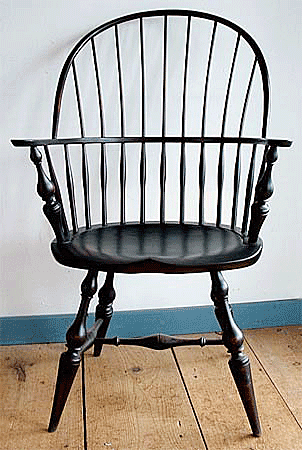 Thomas
Jefferson is said to have penned his first draft of the Declaration of
Independence while sitting in a comb-back Windsor writing chair. Legend has
it that John Quincy Adams liked the hoop-back Windsor best of all the chairs
in his Massachusetts home. And when George Washington retired from the
presidency in 1796, he ordered two dozen Windsors from a Philadelphia
chairmaker for his expansive portico at Mount Vernon. Thomas
Jefferson is said to have penned his first draft of the Declaration of
Independence while sitting in a comb-back Windsor writing chair. Legend has
it that John Quincy Adams liked the hoop-back Windsor best of all the chairs
in his Massachusetts home. And when George Washington retired from the
presidency in 1796, he ordered two dozen Windsors from a Philadelphia
chairmaker for his expansive portico at Mount Vernon.
Through the 18th and 19th centuries, Windsor chairs were
everywhere. The rich used them as outdoor furniture on porches and lawns.
The not-so-rich used them indoors. Taverns ordered them by the dozen. Their
delicate spindle backs are visible in the portraits of many an early
American. And when the Continental Congress ordered Independence Hall
refurbished in 1778, chairmaker Francis Trumble supplied new Windsors.
The Windsor ranks as the most popular and enduring furniture design in
American history. It became the generic chair in house inventories. It was
in the kitchen, by the bed, in the dining room, out on the porch, under the
trees. It was something to sit on. It was a stepping stool. People could
thrust a broomstick between the backs of two of them to create a drying rack
for towels or just-dipped candles. Plus, the wooden seat was more
comfortable that it looked, being slightly dished for comfort.
The Cinderella of Chairs
Just as Cinderella snuck out of the kitchen and got quite
dressed up so did the Windsor chair. Other early chair forms consisted of a
box with legs on which, or into which, a chairmaker could set the seat. The
Windsor had four splayed out legs under the seat which was also chamfered,
or undercut, lightening the look.
 The
Windsor chair was a bold departure from the standard techniques of early
18th-century chairmaking. More varied stylistic influences contributed to it
than any other type of seating. Introduction of the Windsor chair to America
From England probably occurred between 1726 and 1736 through a Pennsylvania
governor appointed by the Penn family, but English chairmakers continued to
supply the basic prototypes until the end of the 18th century. The
Windsor chair was a bold departure from the standard techniques of early
18th-century chairmaking. More varied stylistic influences contributed to it
than any other type of seating. Introduction of the Windsor chair to America
From England probably occurred between 1726 and 1736 through a Pennsylvania
governor appointed by the Penn family, but English chairmakers continued to
supply the basic prototypes until the end of the 18th century.
From the beginning American Windsor chair makers were receptive to secondary
influences drawn from both formal and popular domestic seating styles, thus
giving their pieces a distinctive American flair. After 1800, European style
books heavily influenced American Windsors as formal styles filtered down to
the popular level. But by the 19th century, American and English Windsor
patterns began to go in different directions. While English chairmakers
continued to modify their 18th-century patterns, their American
counterparts, freer from tradition and class constraints, continued to
innovate.
American Windsors first appeared in Philadelphia, and the city became the
center of the Windsor-chairmaking industry in North America from the late
1740s until the early 1800s. Philadelphia’s coastal location midway between
New England and the South and within a few weeks sail of the Caribbean
islands encouraged active trade. Local entrepreneurs realized the potential
of the Windsor as early as 1752. Their success and rising demand for the new
chairs encouraged more craftsmen to make Windsors, focusing attention on
them.
This success encouraged craftsmen in Newport, Rhode Island, and New York to
make their own versions of the Windsor before the Revolutionary War. After
the war, more Windsor shops sprang up in most of the important northern
ports. The craft soon spread to the surrounding towns and villages. Its
impact was felt as far north as the maritime provinces of Canada.
The popullarity of the Windsor chair spread. By the 1790s, the peak of
American Windsor design, the Windsor chair had all but driven the
modest-priced competition out of the market and annual production equaled
that of all other seating furniture.
The Agelessness of Windsor Design
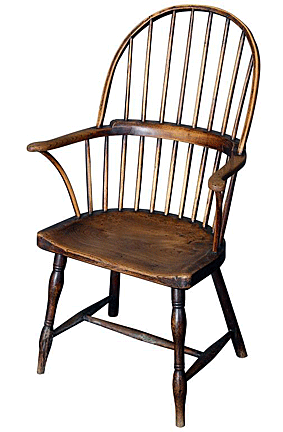 Simple,
utilitarian and made of the most readily available woods, the Windsor
achieved a lean elegance, combining lightness with strength. It had a plank
seat, a back made of spindles, and turned legs socketed into the seat. It
had a sturdy yet graceful style. The Windsor's scooped, saddle seat made it
as comfortable as upholstered furniture. The gracefully curved back and
tapered spindles gave it a look of elegance, and its angled, turned legs
provided both visual attractiveness and physical stability. Simple,
utilitarian and made of the most readily available woods, the Windsor
achieved a lean elegance, combining lightness with strength. It had a plank
seat, a back made of spindles, and turned legs socketed into the seat. It
had a sturdy yet graceful style. The Windsor's scooped, saddle seat made it
as comfortable as upholstered furniture. The gracefully curved back and
tapered spindles gave it a look of elegance, and its angled, turned legs
provided both visual attractiveness and physical stability.
Adapted from a design that originated in England near Windsor Castle, the
American Windsor became a far more popular style than its antecedents.
American Windsors were first called "Philadelphia chairs," for that was
where they were first made. Also known as "stick chairs" (an allusion to the
dozen or more parts assembled to create one), Windsors came in dozens of
varieties: settees, rockers, writing chairs, children's models and, of
course, armchairs. Chairmakers up and down the East Coast developed subtle
interpretations of the turned legs, scrolled arms and rail crests. There
were almost as many saddle-seat patterns as there were makers. These
regional distinctions readily identified the locale and occasionally the
actual chairmaker.
The Windsor was cheap, making it affordable for the middle class. A straight
chair cost $2, a rocker $3.50. And it was inexpensive to make. Chairmakers
used a coat of paint, usually dark green, to conceal that it was constructed
from three common woods, each chosen for what it did best. Soft pine or
poplar for the seat because it was easiest to carve or dish and hard maple
for the legs and spindles, because it could be turned without splintering.
The Windsor is one of the first chair forms to include the option of a
rounded or bowed back.
The Windsor vs. Other Chairs
What exactly distinguished the Windsor from other types of
seating? The main unit of a Windsor chair was a shaped and contoured plane
drilled with sockets on the upper and lower surfaces to anchor the back and
undercarriage. Unlike other seating, the rear legs and upper structure were
separate rather than continuous elements. The individual back members were
vertical, horizontal or curved. Spindles, while a common Windsor component,
were absent on some patterns.
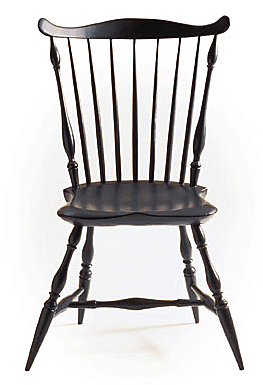 Although
the chair appeared light in form, it had sturdy construction. Unlike other
chairs, its seats didn't require periodic replacement, a coat of paint
freshened scuffed surfaces. Pattern and ornament ranged from plain to
elegant styles, depending on the buyer's pocketbook and needs. Although
the chair appeared light in form, it had sturdy construction. Unlike other
chairs, its seats didn't require periodic replacement, a coat of paint
freshened scuffed surfaces. Pattern and ornament ranged from plain to
elegant styles, depending on the buyer's pocketbook and needs.
Some social historians see American manufacturing history written in the
making of Windsor chairs. They were the first item ever mass-produced in
America, and the manufacture of them heralded the beginnings of
specialization and a sharp division in the ranks of labor and management.
Because each chair consisted of several components, each of which required a
special skill, it was no longer efficient to have a single craftsman produce
a complete chair. Instead, specialists produced identical parts, which
others assembled in factories called "chairworks." By the late 18th century,
a whole class of East Coast craftsmen specialized in making a single
product—the Windsor chair.
From the beginning, American Windsor makers recognized the adaptability of
the Windsor to volume production. Both turned and hand-shaped components
could be made in batches quickly and efficiently to be stockpiled for future
use. The interchangeable nature of Windsor parts led to construction
economies and permitted shop owners to store prepared materials in bulk for
quick assemblage and quantity sales.
By 1800, chairmakers could obtain prepared stock from suppliers who
specialized in producing chair components. But regional design features are
what set Windsors apart from each other. Side chairs were the bread and
butter of the Windsor trade in federal America. Their production greatly
exceeded that of armchairs. Orders for specialized furniture, such as
settees, children's seating, and rocking chairs, provided additional
variations.
Early 19th century work, although innovative, became coarser and relied more
on paint and decoration than on the sculptural qualities of the form. By
mid-century, design creativity had run its course, and the industry turned
to revival styles.
The Making of a Windsor Chair
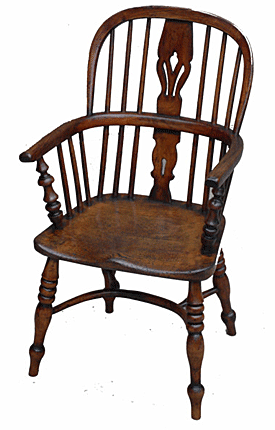 American
Windsors were made mainly from 1726 to 1870. Predominant styles included the
arch-back, arrow-back, bow-back, comb-back, fan-back, loop-back, low-back
and rod-back. Some were also made into writing chairs. By the late 18th
century, some bow, fan, and comb-back models had a central splat with an urn
motif. After 1820, a wheel-pierced splat was used in the center of some
backs. American
Windsors were made mainly from 1726 to 1870. Predominant styles included the
arch-back, arrow-back, bow-back, comb-back, fan-back, loop-back, low-back
and rod-back. Some were also made into writing chairs. By the late 18th
century, some bow, fan, and comb-back models had a central splat with an urn
motif. After 1820, a wheel-pierced splat was used in the center of some
backs.
Like their English counterparts, chairmakers constructed each section of the
chair from the most suitable wood—ash, chestnut, hickory, maple, pine, and
oak. These chairs had characterized by splayed legs which required lengths
of flexible hickory, ash or white oak that could be steamed and bent, much
as basket frames and hunting bows were.
Unlike their American cousins, English Windsors had spindles made of locally
grown beechwood. Some also had cabriole legs, set nearer the edge of the
seat and straighter, with cowhorn-and-spur stretchers. In addition, the back
splats of later models had an inlay of Prince of Wales plumes.
Silhouettes changed as often as dress fashions. Special effects were as
variable as dress fabrics. Chairbacks arched like armorial shields.
Stretchers receded. Frames broke into crests and acquired beading. After
1800, craftsmen began turning spindles to simulate bamboo, then added
decorative striping.
The cylindrical leg that ended in a blunt arrow or a ball, ram’s horn
supports and long serpentine arms were all typical features of Pennsylvania
Windsors. But chairmakers abandoned this form of leg about 1770 for a thick,
short, tapered one. Another feature was the medial stretcher, made of hard
and soft woods and located toward the rear of the side stretchers rather
than in the center.
Pennsylvania chairmakers also produced low-back Windsors. The arm supports
and spindles penetrated the flattened arms but not the applied arm at the
rear of the chair on these chairs. The applied arm also had a concave
indentation running around its back. The flattened arms met the applied arm
in a lap joint. Spindles weren't ornamentally turned, and the seat was
squared off at the front corners. Many authorities have said that the
Pennsylvania low-back Windsor chair was the earliest form of Windsor in the
American style and that the Pennsylvania comb-back Windsor evolved from it.
The Classic Comb-Back Windsor
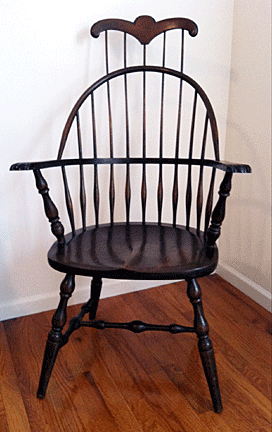 However,
it's generally agreed that the comb-back Windsor chair was the earliest
style produced. It continued to be made in a small number of shops in
Philadelphia and the surrounding counties. The classic comb-back had a
D-shaped seat, nine-spindled back with two smaller arm spindles on each
side, deeply carved ears with a contour level with the crest rail,
urn-shaped turnings at the base of the arm supports, and a decorative medial
stretcher which was " stepped back" from the center of the stretcher. This
model had a back resembling a comb, formed by a continuation of the spindles
through the arms, ending in a comb piece. Arms might have been a single
steam-bent piece of wood, or they might have broken in the rear and have an
applied arm on top. However,
it's generally agreed that the comb-back Windsor chair was the earliest
style produced. It continued to be made in a small number of shops in
Philadelphia and the surrounding counties. The classic comb-back had a
D-shaped seat, nine-spindled back with two smaller arm spindles on each
side, deeply carved ears with a contour level with the crest rail,
urn-shaped turnings at the base of the arm supports, and a decorative medial
stretcher which was " stepped back" from the center of the stretcher. This
model had a back resembling a comb, formed by a continuation of the spindles
through the arms, ending in a comb piece. Arms might have been a single
steam-bent piece of wood, or they might have broken in the rear and have an
applied arm on top.
In early inventories and advertisements the term "sack-back" appears, but no
one knows for certain what type of Windsor chair it refers to. Some
authorities believe it was this type of chair, since a sack could obviously
be tied to the back of the chair to protect the sitter from drafts. The
sack-back Windsor, made from 1785 to 1790, featured bold knuckle-down
armrests and the distinctive profiles of the turnings in the arm supports
and undercarriage and the highly molded, square-front oval seat.
The Bow-Back Windsor
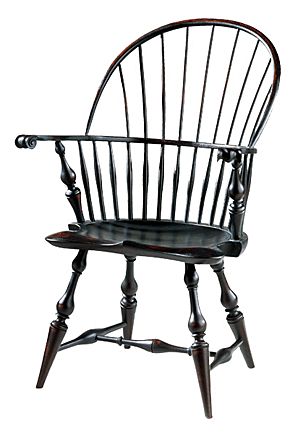 The
bow-back Windsor side chair was, by far, the most popular model. Created by
Walter MacBride of New York sometime between 1792 and 1796, this
continuous-bow Windsor armchair had a well-proportioned design of a sweeping
bow with bends in two planes, which became a classic Windsor form. A
distinctive characteristic of this chair was the full, balloon-shape bow
accompanied by a back brace. The abrupt taper of the feet was a feature
associated with Windsor chairmaking in Rhode Island, particularly during the
1790s. It had a back formed by a bowed crest rail that was mortised and
wedged into curved arms and spindles that extended through the arms up the
crest rail. The arms are almost always a single piece of steam-bent wood,
but some chairs were made with applied arms in the rear. The
bow-back Windsor side chair was, by far, the most popular model. Created by
Walter MacBride of New York sometime between 1792 and 1796, this
continuous-bow Windsor armchair had a well-proportioned design of a sweeping
bow with bends in two planes, which became a classic Windsor form. A
distinctive characteristic of this chair was the full, balloon-shape bow
accompanied by a back brace. The abrupt taper of the feet was a feature
associated with Windsor chairmaking in Rhode Island, particularly during the
1790s. It had a back formed by a bowed crest rail that was mortised and
wedged into curved arms and spindles that extended through the arms up the
crest rail. The arms are almost always a single piece of steam-bent wood,
but some chairs were made with applied arms in the rear.
Chairmaker John Letchworth of Philadelphia is credited with introducing a
highly ornamental version of the bow-back Windsor between 1796 and 1802. The
inspiration for this highly ornamental version of the traditional Windsor
chair was a late Chippendale-style mahogany chair with pierced cross slats
introduced in the Philadelphia market after the Revolution. Chairmakers
often based the turnings of Windsor chairs on the rush-bottomed bannister
and slat-back chairs produced earlier in the 18th century.
The Windsor most closely associated with southeastern Massachusetts and
Nantucket is a tall fan-back armchair produced between 1790 and 1805. The
extreme rake of the back produces an "easy" chair. Nantucket chairmakers
sometimes referred to this as a "man's chair."
Much repaired though the frames of early Windsors have been over the
centuries, these chairs will never tip. Whoever built Windsors built them
for the ages.
<
Back to
Antiques Articles
Go to the next antiques article > |
|
